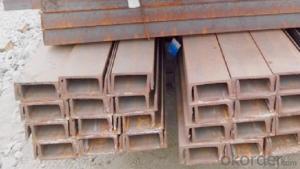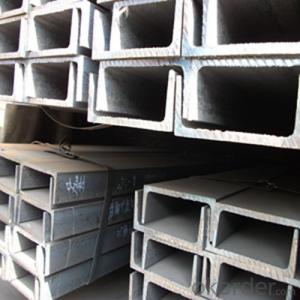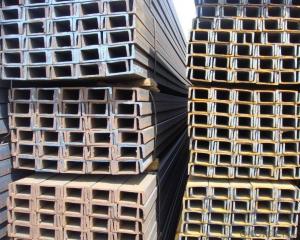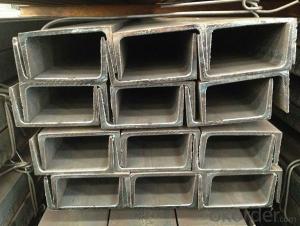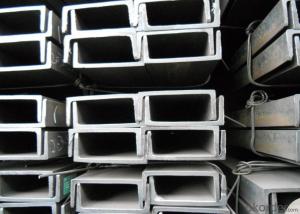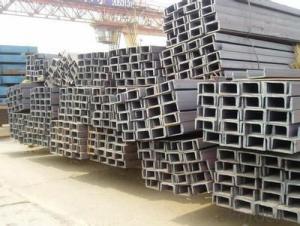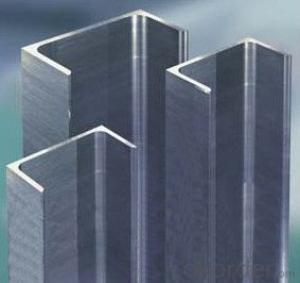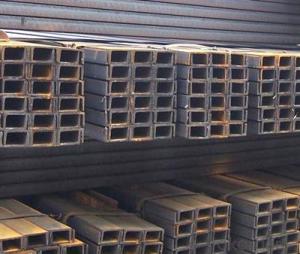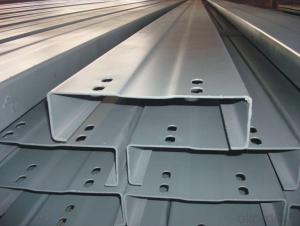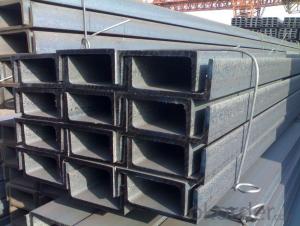Hot Rolled Channel Steel AISI,ASTM,BS,DIN,GB,JIS Standard
- Loading Port:
- Tianjin
- Payment Terms:
- TT OR LC
- Min Order Qty:
- 2000 PCS
- Supply Capability:
- 40000 PCS/month
OKorder Service Pledge
OKorder Financial Service
You Might Also Like
Hot Rolled Channel Steel AISI,ASTM,BS,DIN,GB,JIS Standard Details
| Standard: | AISI,ASTM,BS,DIN,GB,JIS | Dimensions: | 5#--32A# | Grade: | Q235.SS400.Q345 etc. |
| Place of Origin: | China (Mainland) | Brand Name: | TSSC | Shape: | U Channel |
| Application: | construcal | Perforated Or Not: | Not Perforated |
Packaging & Delivery
| Packaging Detail: | export standard by container or bulk packing |
| Delivery Detail: | within 30 days |
Hot Rolled Channel Steel AISI,ASTM,BS,DIN,GB,JIS Standard Specifications
Size | Width Depth (mm) | Width Depth (mm) | waist depth (mm) | leg depth (mm) | theoretical weight (kg/m) | Tolerance |
7.5 | 75 | 40 | 4 | 7 | 5.6 | 3-5% |
7.5 | 75 | 40 | 4.5 | 7 | 5.85 | 3-5% |
7.5 | 75 | 40 | 5 | 7 | 6.92 | 3-5% |
10 | 100 | 50 | 3.8 | 6 | 7.3 | 3-5% |
10 | 100 | 50 | 4.2 | 6 | 8.03 | 3-5% |
10 | 100 | 50 | 4.5 | 7.5 | 8.97 | 3-5% |
10 | 100 | 50 | 5 | 7.5 | 9.36 | 3-5% |
12.5 | 125 | 65 | 5.2 | 6.8 | 11.66 | 3-5% |
12.5 | 125 | 65 | 5.3 | 6.8 | 12.17 | 3-5% |
12.5 | 125 | 65 | 5.5 | 8 | 12.91 | 3-5% |
12.5 | 125 | 65 | 6 | 8 | 13.4 | 3-5% |
15 | 150 | 75 | 5.5 | 7.3 | 14.66 | 3-5% |
15 | 150 | 75 | 6.5 | 10 | 16.71 | 3-5% |
15 | 150 | 75 | 5.5 | 10 | 17.9 | 3-5% |
15 | 150 | 75 | 6.5 | 10 | 18.6 | 3-5% |
Hot Rolled Channel Steel AISI,ASTM,BS,DIN,GB,JIS Standard Pictures
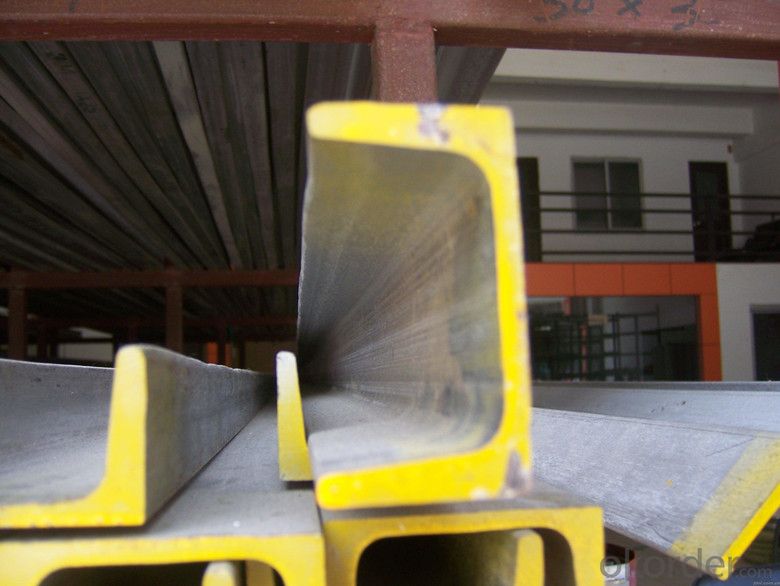
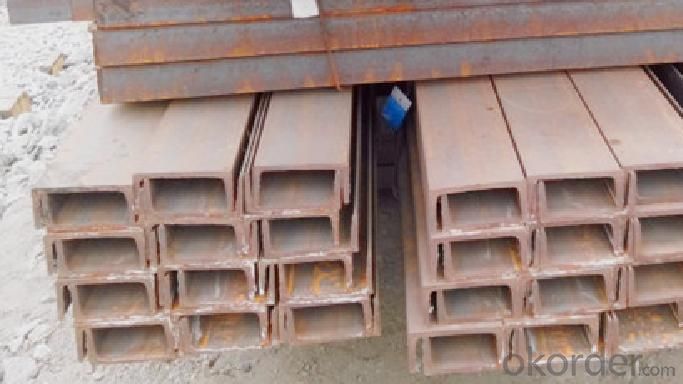
- Q: Are steel channels suitable for use in automotive applications?
- Yes, steel channels are suitable for use in automotive applications. They provide strength, stability, and durability, making them ideal for various structural and framing components in vehicles. Steel channels can withstand high loads and impacts, ensuring the safety and reliability of automotive designs.
- Q: Are steel channels suitable for electrical conduit systems?
- Yes, steel channels can be suitable for electrical conduit systems. Steel channels provide durability, strength, and protection for electrical wires and cables. They can withstand harsh environments, offer high load-bearing capacity, and protect against mechanical damage. Additionally, steel channels can be easily installed and provide a reliable and long-lasting solution for electrical conduit systems.
- Q: Channel and channel steel, hot rolled and cold rolled sheet in the production process, product characteristics above what is easy to understand, give me hope!
- Because of the difference of production process between them, the performance of them is different greatly. The strength of hot rolled steel or hot-rolled steel is lower than that of cold rolling, but the plastic deformation ability is stronger.
- Q: What are the different lengths available for steel channels?
- The lengths available for steel channels vary depending on the manufacturer and supplier. Common lengths for steel channels range from 20 feet to 40 feet, but custom lengths can also be ordered to suit specific project requirements.
- Q: What is the weight-bearing capacity of steel channels?
- The weight-bearing capacity of steel channels varies depending on their dimensions, thickness, and quality. It can range from a few hundred pounds to several tons, making them suitable for a wide range of structural applications.
- Q: What are the different types of loads that steel channels can bear?
- Steel channels are versatile structural components that can bear various types of loads. The different types of loads that steel channels can bear include: 1. Compression Load: Steel channels have a high load-bearing capacity and can withstand compression forces. They are commonly used in columns and beams to support the weight of a structure or transfer loads vertically. 2. Tension Load: Steel channels are also capable of bearing tension loads. They can resist forces that tend to pull or stretch the material, making them suitable for applications such as trusses or suspension systems. 3. Shear Load: Steel channels can withstand shear forces, which occur when two forces act parallel to each other but in opposite directions. They are commonly used in structural systems to resist the shearing effects of horizontal loads, such as wind or seismic forces. 4. Bending Load: Steel channels can bear bending loads, which occur when a force is applied perpendicular to the axis of the channel. They are often used as beams or lintels to support loads over openings like doors or windows. 5. Axial Load: Steel channels are designed to bear axial loads, which act along the longitudinal axis of the channel. These loads can be compressive or tensile and are typically encountered in columns or vertical members. 6. Lateral Load: Steel channels can also bear lateral loads, which act perpendicular to the longitudinal axis of the channel. These loads can arise from wind, earthquakes, or other horizontal forces and are resisted by the structural system where the channel is incorporated. Overall, steel channels are a versatile choice for structural applications due to their ability to bear various types of loads. Their strength, durability, and flexibility make them suitable for a wide range of construction and engineering projects.
- Q: What are the different types of connections for steel channels in curtain wall systems?
- There are several types of connections used for steel channels in curtain wall systems, including bolted connections, welded connections, and adhesive connections. Bolted connections involve using bolts and nuts to secure the steel channels to the framing members. Welded connections involve melting the steel channels and the framing members together to create a strong bond. Adhesive connections involve using specialized adhesives to bond the steel channels to the framing members. Each type of connection has its own advantages and considerations depending on factors such as load requirements, ease of installation, and aesthetic preferences.
- Q: How are steel channels resistant to corrosion?
- Steel channels are resistant to corrosion due to the presence of a protective oxide layer on their surface. This oxide layer forms naturally through a process called passivation, where a thin layer of chromium oxide is created on the steel's surface when it is exposed to oxygen in the air. This oxide layer acts as a barrier that prevents oxygen and moisture from coming into contact with the underlying steel, thereby inhibiting the corrosion process. Additionally, steel channels can also be further protected from corrosion through the application of various coatings and treatments such as galvanization or painting. These measures provide an additional layer of protection against the corrosive elements, thereby enhancing the overall corrosion resistance of steel channels.
- Q: Can steel channels be used for supporting HVAC systems?
- Yes, steel channels can be used for supporting HVAC systems. Steel channels are typically made of durable and strong steel material, making them suitable for providing structural support to HVAC equipment. They are often used in conjunction with other support materials, such as brackets and hangers, to securely hold and suspend HVAC units, ductwork, and piping. Steel channels offer several advantages for supporting HVAC systems. Firstly, they have high load-bearing capacity, ensuring that the weight of the HVAC equipment and components is adequately supported. Additionally, steel channels are resistant to corrosion and can withstand harsh environmental conditions, making them suitable for both indoor and outdoor applications. Steel channels also provide flexibility in terms of installation. They can be easily adjusted and customized to accommodate different HVAC system configurations. Moreover, steel channels can be installed using various methods, such as welding, bolting, or clamping, offering versatility in the installation process. It is important to ensure that the steel channels used for supporting HVAC systems are designed and installed according to industry standards and local building codes. Proper engineering and design considerations, including load calculations, seismic requirements, and thermal expansion, should be taken into account to ensure the safety and stability of the HVAC system. Overall, steel channels are a reliable and commonly used method for supporting HVAC systems, providing strength, durability, and flexibility in installation.
- Q: How do steel channels perform under dynamic loads?
- Steel channels are known for their high strength and load-bearing capacity, making them well-suited for handling dynamic loads. When subjected to dynamic loads, such as vibrations, impacts, or fluctuating forces, steel channels exhibit excellent performance and durability. The structural design of steel channels allows them to effectively distribute dynamic loads throughout their length, preventing localized stress concentrations. This characteristic minimizes the risk of fatigue failure, which is crucial in applications where repeated loading occurs. Steel channels also possess good stiffness, which helps to maintain their shape and integrity under dynamic loads. This stiffness allows them to resist bending, twisting, or deforming, ensuring the overall stability and safety of the structure. Additionally, steel channels are highly ductile, meaning they can withstand significant deformation without fracturing. This ductility is essential in absorbing and dissipating energy during dynamic loading events, such as impacts or earthquakes, reducing the risk of catastrophic failure. Furthermore, steel channels are often used in conjunction with other structural components, such as bolts, welds, or connectors, to enhance their load-bearing capacity. The combination of steel channels with these reinforcements further improves their performance under dynamic loads by increasing their resistance to shear, torsion, and bending forces. In summary, steel channels are well-suited for handling dynamic loads due to their high strength, excellent load distribution capabilities, stiffness, ductility, and compatibility with reinforcements. These qualities make them a reliable choice for various applications that require withstanding dynamic forces, ensuring the durability and safety of the structures they are used in.
Send your message to us
Hot Rolled Channel Steel AISI,ASTM,BS,DIN,GB,JIS Standard
- Loading Port:
- Tianjin
- Payment Terms:
- TT OR LC
- Min Order Qty:
- 2000 PCS
- Supply Capability:
- 40000 PCS/month
OKorder Service Pledge
OKorder Financial Service
Similar products
Hot products
Hot Searches
Related keywords
